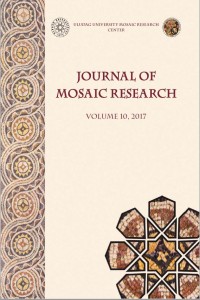Roma Mozaiğinin İkonografik Konularının Seçiminde Sanatın Hıristiyanlaştırılması; Praeparatio Euangelica Kavramı
Abstract
Yukarıda adı geçen Latince deyim, çok tanrılı dinden Hıristiyanlığa giden yolun “ex machina”dan değil, aynı
zamanda çok tanrılı dinlerde süreklilik gösteren dindarlık deneyiminden geçtiğini ifade etmektedir. Evangelist
olduğu söylenen bir oluşum küçük küçük ve pek çok yolla Hıristiyan vahiylerini, tüm Roma İmparatorluğu’na
ulaştırmaktadır. Bu klasik sanatın evriminde, özellikle en iyi örnekleri mozaik sanatında, diğer anlamlı mitlerin
arasında bilhassa Orpheus’un hikayesinde görülebilir. Dolayısıyla klasik mitlere yeni yaklaşımların önemi,
yani “opus musivum’da” temsil edilmeleri ele alınacaktır.
References
- M. F. Abraços, 2005, Para a História da Conservação e Restauro do Mosaico Romano em Portugal, PhD Thesis, University of Lisbon, Lisboa.
- J. Alarcão, 1988, O Domínio Romano em Portugal, Paperback, Publicações Europa-América, Lisboa.
- J. M. Bairrão Oleiro, 1992, Conimbriga, Casa dos Repuxos in Corpus dos Mosaicos Romanos de Portugal. Conventus Scallabitanus. I+II, Conímbriga.
- M. J. Duran Kremer, 1999, Die Mosaïken der villa Cardilio (Torres Novas, Portugal). Ihre Einordnung in die musivische Landschaft der Hispania im allgemeinen und der Lusitania im besonderen, PhD Thesis, University of Trier, Trier.
- J. Lancha – P. André, 2000, A villa romana de Torre de Palma in Corpus dos Mosaicos Romanos de Portugal, Conventus Pacensis 1, I+II. Lisboa.
- J. Lancha – C. Oliveira, 2013, Algarve Este in Corpus dos Mosaicos Romanos de Portugal, Conventus Pacensis 2, Faro.
- A. M. Manière-Lévêque, 2012, Xanthos, Part 2, The West Area, Corpus of the Mosaics of Turkey II, Lycia, İstanbul, Ege Yayınları.
- M. P. Raynaud, 2009, Xanthos, Part 1, The East Basilica, Corpus of the Mosaics of Turkey I, Lycia, İstanbul, Ege Yayınları.
- H. Stern, 1955, “La mosaïque d’Orphée de Blanzy-lès-Fismes (Aisne)”, Gallia 13-1, 41-77.
From the Concept of Praeparatio Euangelica to the Christianization of Art, Especially in the Choice of Iconographic Subjects of the Roman Mosaic
Abstract
As the Latin phrase in the above title says, the passage from paganism to Christianity does not arise ex machina,
but it is also prepared through the continuous experience of religiosity in pagan contexts. There is a preparation
that is said to be evangelical, because little by little and in many ways, the Christian Good News reaches
the whole Roman Empire. This is visible in the evolution of classical art, especially in the mosaic, with the best
examples, among other significant myths, of Orpheus’s story. Hence the importance of new approaches to classical
myths, namely in their representation in opus musivum.
References
- M. F. Abraços, 2005, Para a História da Conservação e Restauro do Mosaico Romano em Portugal, PhD Thesis, University of Lisbon, Lisboa.
- J. Alarcão, 1988, O Domínio Romano em Portugal, Paperback, Publicações Europa-América, Lisboa.
- J. M. Bairrão Oleiro, 1992, Conimbriga, Casa dos Repuxos in Corpus dos Mosaicos Romanos de Portugal. Conventus Scallabitanus. I+II, Conímbriga.
- M. J. Duran Kremer, 1999, Die Mosaïken der villa Cardilio (Torres Novas, Portugal). Ihre Einordnung in die musivische Landschaft der Hispania im allgemeinen und der Lusitania im besonderen, PhD Thesis, University of Trier, Trier.
- J. Lancha – P. André, 2000, A villa romana de Torre de Palma in Corpus dos Mosaicos Romanos de Portugal, Conventus Pacensis 1, I+II. Lisboa.
- J. Lancha – C. Oliveira, 2013, Algarve Este in Corpus dos Mosaicos Romanos de Portugal, Conventus Pacensis 2, Faro.
- A. M. Manière-Lévêque, 2012, Xanthos, Part 2, The West Area, Corpus of the Mosaics of Turkey II, Lycia, İstanbul, Ege Yayınları.
- M. P. Raynaud, 2009, Xanthos, Part 1, The East Basilica, Corpus of the Mosaics of Turkey I, Lycia, İstanbul, Ege Yayınları.
- H. Stern, 1955, “La mosaïque d’Orphée de Blanzy-lès-Fismes (Aisne)”, Gallia 13-1, 41-77.
Details
| Subjects | Archaeology |
|---|---|
| Journal Section | Article |
| Authors | |
| Publication Date | November 30, 2017 |
| Published in Issue | Year 2017 Issue: 10 |

